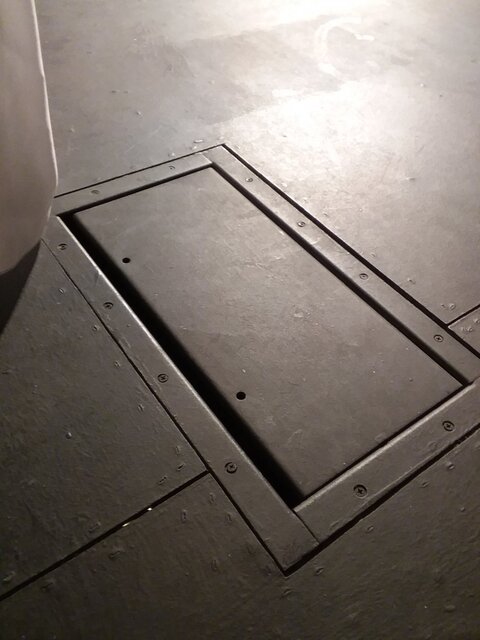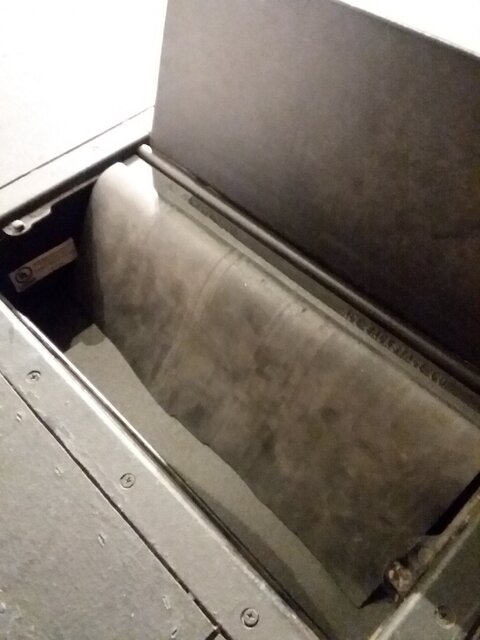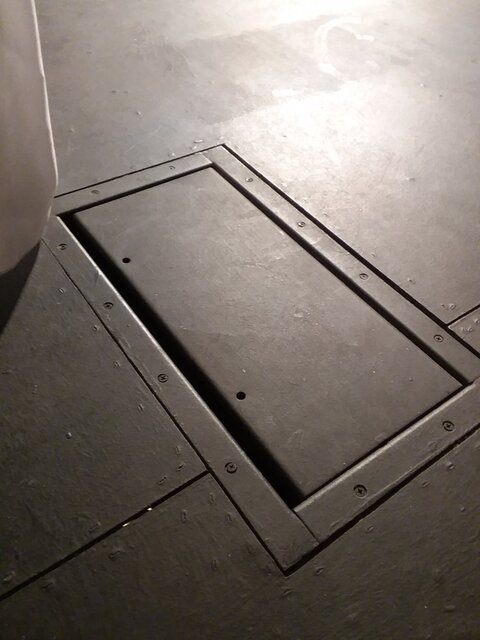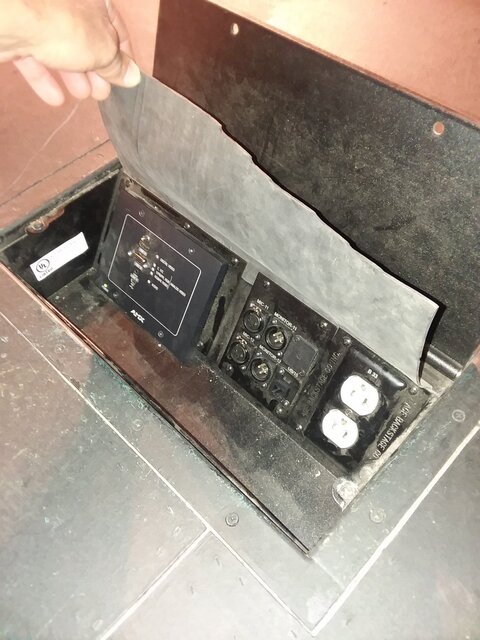Was wondering about the brand. Not very deep in doing a good job of letting the cable train itself out. Good ideas above. Also think about the rubber sheeting used on follow spots for the focus rods in doing similar A decent in this case 1/4" rubber glued to the underside of the
cover, and slit for cable openings as with the (?roofing felt paper or rubber
flat roof material) above might be useful in helping keep debree out. if periodically vaccumed what might collect in the cast cable openings. Yes! keep man-lifts away from floor pockets as an active thing to watch for while driving! Weep holes, yes and necessary, the angle and location of the outlets should keep water away, but
dead end plugs - especially if a rubber cork is put in the
cord grip of that
outlet dead
plug.
In general, one should not be mopping that wet this would be a problem of dripping to the floor below... if doing it properly for a
stage. Believe the training I was given was three clampings of the mop.
Brilliant ideas of especially when 1/4"
masonite on the
stage - plugs, and or even taping the holes not used or painters/
gaff tapping the pocket openings when away. Tape of any type gets nasty especially with time or not used theater getting hot, but prefer over the school staff making it unusable. On the other
hand, if you once let them make you crack the plate to get it open... don't chip away what they did. This is sealant against mopping or further paint. Granted tape next time afterwards.
Seen a few
Hub Electric ones from the 50's in a glossy
stage Gymatorium which were
Polyurethane sealed tight. Floor pockets have a proper use in as opposed to running cables across the floor to the nearest wall
outlet, (That in outlets designeted for the
Cyc or Procenium
boom) or should that
boom need to be moved away or gone for scene change needs - not practicle to get the ladder out so as to un-connect and remove the
boom if it needs to go away between scenes. Glad to hear floor pockets still in use and even
ethernet/
DMX capable as with probably
stage pin + say 208v options. Never thought about it, but would be a great thing in advancing for their proper use.
Back... 25+ years ago, I started working alot at the 1911 Athanaeum Theater in Chicago. It had floor pockets in constant use especially for dance shows. Never had a problem in painting, or washing in three times straining the excess water off the mop - important. You had to refresh the mop no doubt more, but in general, if you have watter dripping into the band room, your
stage deck is also not feeling so well with that amount of water. If still dirty... mop it again, and I did.
They had 1911 floor pockets which I converted to grounded for the 20A
stage pin, but I still had to deal with the constant use for a 7th
circuit of 30A
Stage plug outlets on them with converter to 20A
stage pin!!!
Stage plug was basically a wooden handle with two copper sheets applied to it, and in the
floor pocket, very exposed sister plates and terminals (at least in the worst circumstance. Would have to re-visit a Wall of shame sample to verify that the female live side also had live plates.) These floor pockets were un-lit and fairly deep and dark. Years later, even after upgrading the floor pockets, I learned the floor pockets in 1911 were internally lit. (Believe I know this, or this was an option on such floor panels I dealt with) I didn't notice a lamp
socket in them, but suspect for at least 1911
safety in plugging in the
stage plug.. one would want some light in otherwise dark. When I was plugging on the 30A
Stage Plugs, luckily they were not live and I didn't need to be in the box plugging in or removing booms in the dark. Such 30A
Stage plugs were for a
carbon arc wash light or PC
fixture which the
stage hand would also have to be Very Much around to adjust the arc. This unless the as if moving light, self adjusting arm assembly was added cost to be invested in. Depends on the
fixture, but in general a lot of back
stage people had posts in the 1911 period to move scenery Screw in them
stage screws for braces, tie the flats
etc. or during the show
strike an arc or adjust/maintain
carbon arc rods. And remember those guys in the day no matter the heat were mostly dressed well in not just Tee-shirt but shirt and other clothing... not even blue jeans or shorts.
Study into the Iriquis Theater Fire - important reading... two books on it I'm aware of and read. Good reading and easy term papers.
Authentic leather bound "Season 1916-1917 Chicago
Stage Lighing Co." I bought off the net... Fascinating catalogue of rental equipment from them. Later pages is a calander from appairently a crew chief in listing names of people for each date working with him. Owner of the pocket catalogue had bad
hand writing as per uncharictic from that day and time in at times quickly written words and smears from ink. His personal info was much more careful - a pocket sized rental catalogue with contact info for who to hire, calander to who was hired, financial
tracking on them, also provided a more carefully written "Identification"
page. This from a rental/sales cataloge from a lighting company.
Leo W Souger, Marientvell, IL (Cursive writing on town confusing.) Lists his parents in case of accident. He weighed 136#, and was 5'4" (fascinating the actual lines are crossed out and above them written in "99.1/2# & 4'-11") So perhaps in 1916, that was him and corrected later. He owned a Buick #791 (what ever that means.) And a Mead bike. Goes into shoes I cannot read, size 10 socks (Hosiery), Hat - 7.1/2, Collar 13.1/2, Shirt... believe in a smear, 18, Undershirt 36, Drawers 36, Gloves 8, Waist... 32"
We now know a lot about a
stage hand back in 1916' and he was plugging dangerous
stage plugs into hopefully lit floor pockets.... or was that an option?
https://en.wikipedia.org/wiki/Leo_Sugar... Perhaps?






